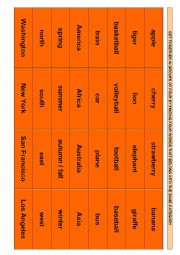
|
Activity cards to form groups of four
Each student draws ONE card.
Then students walk around and try to find other students whose cards belong to the same category. There are four cards for each category. This means that after a few minutes, groups of four students should emerge.
Level: elementary
Age: 6-100
Type: activity-card
Downloads: 9
|
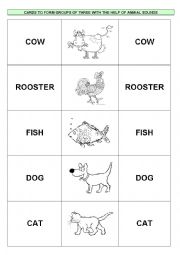
|
Activity cards to form groups of three (animal noises)
This is how the cards should be used:
Each kid draws a card and MUST NOT show it to anybody else. Then the kids walk around in the classroom QUIETLY. However, when they meet somebody, they shake hands and introduce themselves by making the noise of the animal given on their card. (Miaow, Moooh, Baa-baa, Bow-wow .....) They should do this at a re...
Level: elementary
Age: 6-100
Type: activity-card
Downloads: 10
|
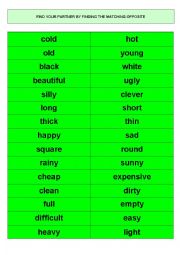
|
Activity cards to form pairs (contrasts)
These are activity cards for pair formation in a group of language learners. The students have to find the partner whose card gives the opposite of the word on their own card.
Level: elementary
Age: 6-100
Type: activity-card
Downloads: 29
|

|
Alfred Nobel and the Nobel Prize
An short biography of Alfred Nobel and the history behind the famous Nobel Prize.
There is a question section as a follow-up activity.
Level: intermediate
Age: 12-100
Type: worksheet
Downloads: 96
|
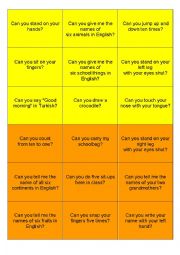
|
Can you ...........
These are activity cards for beginners.
The activity can be done in pairs or threes or fours.
Each group is given a set of cards and shoudl put them on their desks, face down.
Student 1 takes a card and asks student 2: CAN YOU ....
Student 2 has two options.
Either the answer is YES, I CAN, or the answer is NO, I CAN�T.
If the answer is NO...
Level: elementary
Age: 7-17
Type: activity-card
Downloads: 20
|
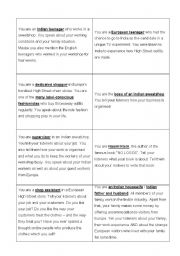
|
Fashion "made in India"
We read an article about Indian teenagers working in sweatshops producing cheap garments for American and European high street fashion stores.
This is a follow-up activity where students are expected to adopt a wide variety of viewpoints and to discuss the issue of "fashion" according to their viewpoints.
Level: advanced
Age: 14-17
Type: activity-card
Downloads: 23
|
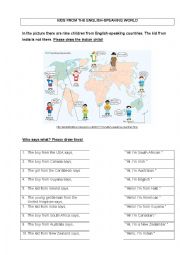
|
Kids from the English speaking world
This worksheet was used in a beginners� class, introducing kids from English speaking countries. With the help of a picture, pupils are expected to match countries (e.g. Britain, Ireland, Canada) with adjectives (British, Irish, Canadian)
As the picture accompanying the task is incomplete, there is a little drawing activity integrated into the ex...
Level: elementary
Age: 7-14
Type: worksheet
Downloads: 29
|

|
Moving out of the parental nest
A visual impulse plus impulse questions about the pros and cons of leaving home and living independently after graduating from high school. An ideal conversation activity for students in their last school year before university.
Level: advanced
Age: 14-17
Type: worksheet
Downloads: 47
|
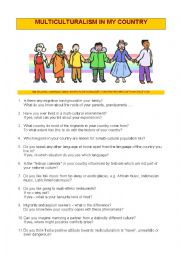
|
Multiculturalism in my country
These are a number of questions designed for oral work in the classroom, i.e. for a conversation class. The questions hopefully stimulate the students to present the issue of multiculturalism and migration in the countries they come from, and to discuss potential differences and similarities.
Level: advanced
Age: 14-17
Type: worksheet
Downloads: 70
|
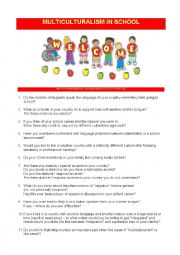
|
Multiculturalism in the classroom
These are a number of questions designed for oral work in the classroom, i.e. for a conversation class. The questions hopefully stimulate the students to present the issue of multiculturalism and migration in the classrooms and in the schools of their country.
Level: advanced
Age: 14-17
Type: worksheet
Downloads: 41
|